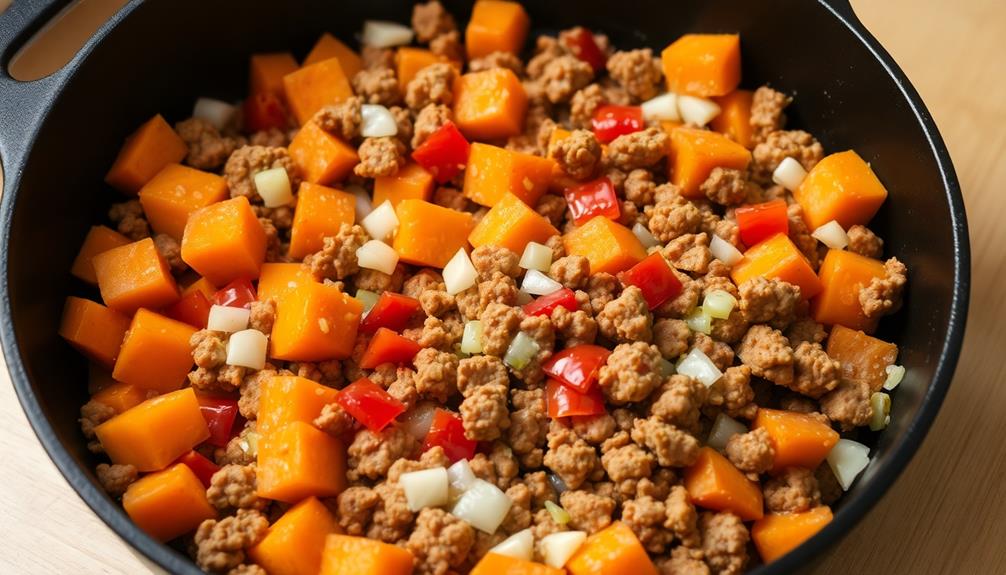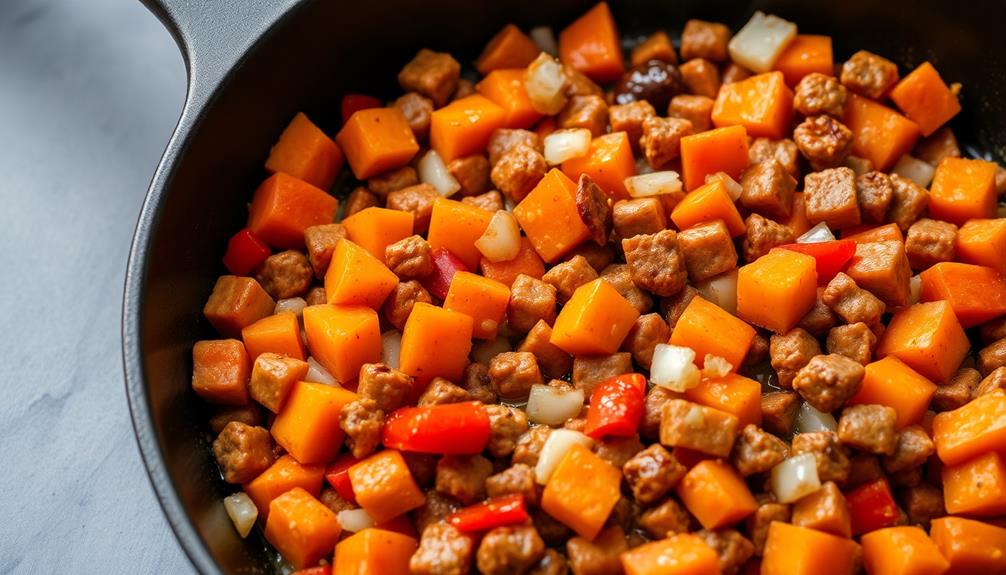Cyclical keto offers the flexibility to incorporate carb refeeds that replenish glycogen stores and boost your metabolism. You'll alternate between strict ketogenic eating and higher-carb periods, which can enhance athletic performance and prevent the metabolic slowdown associated with long-term keto. The key is finding the right balance – not going overboard on refeeds while ensuring adequate restriction on keto days. Monitoring your body's responses will help you personalize the approach. With discipline and patience, you'll discover the cyclical keto strategy that energizes you best. Let's dive into the details and explore how to make it work for your goals. To make cyclical keto work for you, it’s important to plan ahead and have a variety of keto meal prep ideas ready for both your low-carb and higher-carb days. This will ensure that you stick to your macro goals and avoid overeating on your carb refeeds. By experimenting with different meal combinations and timing of refeeds, you can tailor the cyclical keto approach to your individual needs and preferences. With a bit of trial and error, you’ll find the right balance that supports your fitness goals and overall well-being.
Key Takeaways
- Cyclical keto involves alternating strict ketogenic eating with higher-carbohydrate "refeed" periods to support athletic performance and prevent metabolic slowdown.
- Refeeds help replenish glycogen stores and boost metabolism, but require discipline to avoid excessive carb intake on refeed days.
- Individual responses to refeeding vary, so flexibility and personalization are crucial for finding the right balance and frequency of refeeds.
- Observing body responses and adjusting the protocol as needed can help optimize energy levels and focus throughout the cyclical keto journey.
- Incorporating finishing touches like fresh herbs can enhance the visual appeal and flavor balance of cyclical keto meals.
History
The origins of cyclical keto can be traced back to the 1970s, when researchers began exploring the potential benefits of intermittent fasting and low-carbohydrate diets.
These early studies found that cycling between periods of low-carb and higher-carb intake could offer advantages over strict, continuous keto. The idea was that the higher-carb "refeed" phases could help replenish glycogen stores, boost metabolism, and improve mood and energy levels.
Over the decades, the cyclical keto approach evolved, with bodybuilders and athletes adopting it to support their training and recovery.
Proponents claimed it could enhance fat loss, build muscle, and provide a mental and physical boost. As the keto diet gained mainstream popularity in the 2010s, cyclical variations became more widely discussed and practiced.
Today, it's seen as a flexible way to enjoy the benefits of keto while avoiding some of the potential drawbacks of a constant state of ketosis.
Recipe
Cyclical keto is a dietary approach that involves alternating between periods of strict ketogenic eating and higher-carbohydrate periods. This cycling can help maintain ketosis while providing the body with a periodic influx of carbohydrates to support athletic performance, replenish glycogen stores, and prevent the metabolic slowdown that can occur with long-term, rigid keto dieting.
Additionally, incorporating nutrient-dense ingredients, like those found in high antioxidant foods, can further enhance your overall health and well-being.
One classic cyclical keto meal is a keto-friendly breakfast hash. This dish allows you to pack in nutrient-dense ingredients while keeping the carb count low during a keto phase, making it an excellent option for fueling your day.
- 2 cups cubed sweet potato
- 1 lb ground breakfast sausage
- 1 onion, diced
- 2 cloves garlic, minced
- 1 red bell pepper, diced
- 4 eggs
- 2 tbsp avocado oil
- 1 tsp smoked paprika
- Salt and pepper to taste
In a large skillet, heat the avocado oil over medium-high heat. Add the sweet potato cubes and sauté for 5-7 minutes, until lightly browned.
Add the sausage, onion, garlic, and bell pepper. Cook for another 5-7 minutes, breaking up the sausage as it cooks, until the vegetables are tender and the sausage is cooked through.
Create wells in the hash and crack the eggs directly into the wells. Cover the skillet and cook for 4-6 minutes, until the eggs are set to your desired doneness. Season with smoked paprika, salt, and pepper.
This breakfast hash is a great way to enjoy the benefits of cyclical keto. The sweet potato provides a carb-up during your higher-carb phases, while the sausage, eggs, and vegetables keep the dish keto-friendly during your strict keto periods.
Enjoy this dish as part of a balanced cyclical keto lifestyle.
Cooking Steps
Sauté the onions and garlic in a skillet until fragrant.
Then, add the mushrooms and spinach, cooking until the veggies are tender.
Next, stir in the tomatoes and your favorite seasonings.
Finally, top it all off with a sprinkle of cheese and a splash of cream for a creamy, flavorful dish.
Garnish with fresh basil before serving.
Step 1. Sauté Onions and Garlic

Finely chop the onions and mince the garlic. You'll want to work quickly so the flavors develop.
In a large skillet over medium heat, add a tablespoon of olive oil. Once the oil is shimmering, add the chopped onions. Sauté for 3-4 minutes, stirring occasionally, until the onions are translucent and starting to soften.
Incorporating ingredients like garlic can enhance the nutritional profile of your meal, adding beneficial compounds found in many health-focused recipes.
Then, toss in the minced garlic. Continue sautéing for another 1-2 minutes, being careful not to let the garlic burn. The aromatic blend of onions and garlic will fill your kitchen, signaling it's time to move on to the next step.
Remember to season with a pinch of salt and pepper to taste. This simple sauté lays the flavor foundation for the rest of your cyclical keto dish.
With the onions and garlic prepped, you're well on your way to a delicious, keto-friendly meal.
Step 2. Add Mushrooms and Spinach

Next, grab a pack of fresh mushrooms and give them a good rinse. Slice the mushrooms into thin, even pieces, ensuring they'll cook evenly.
Grab a few handfuls of fresh spinach leaves and give them a quick wash as well. You'll want to roughly chop the spinach so it's easier to incorporate into the dish.
Now, heat a tablespoon of olive oil in a large skillet over medium-high heat. Toss in the sliced mushrooms and sauté for 5-7 minutes, stirring occasionally, until they've softened and browned nicely.
Once the mushrooms are ready, add the chopped spinach to the pan. Sauté for another 2-3 minutes, just until the spinach has wilted down.
Season the mixture with a pinch of salt and pepper to taste.
The mushrooms and spinach are now ready to be incorporated into your cyclical keto meal. This nutritious veggie duo will add great flavor and texture to your dish.
Step 3. Add Tomatoes and Seasonings

With the mushrooms and spinach ready, it's time to add some fresh tomatoes to the mix. Dice up a few ripe tomatoes and toss them into the pan. The juicy tomatoes will add a burst of flavor and extra moisture to balance out the other ingredients.
Now, it's time to season things up. Sprinkle in a teaspoon of dried oregano and a pinch of garlic powder. You can also add a dash of salt and pepper to taste. These simple seasonings will elevate the dish, making it even more delicious.
Stir everything together and let the tomatoes and spices meld with the mushrooms and spinach. The mixture should come together nicely, creating a colorful and flavorful blend.
This veggie-packed addition to your cyclical keto meal is sure to satisfy. Enjoy the fresh, savory flavors as you nourish your body during this carb-refeed phase.
Step 4. Add Cheese and Cream

After sautéing the veggies, you'll want to add some creamy elements to the dish. First, sprinkle in a handful of shredded cheddar or mozzarella cheese. The cheese will melt into the mixture, adding a delicious creaminess.
Incorporating fresh, unprocessed ingredients can enhance the overall health benefits of your meal, aligning with the principles of a raw food diet. Next, pour in a splash of heavy cream or full-fat coconut milk. This will further enrich the dish and create a luxurious texture.
Remember to stir everything together gently to incorporate the cheese and cream evenly. The cheese and cream will complement the savory flavors of the sautéed veggies, creating a well-balanced and satisfying meal.
Feel free to adjust the amounts of cheese and cream to suit your taste preferences. Just be mindful not to overdo it, as you still want the flavors of the other ingredients to shine through.
With the addition of cheese and cream, your cyclical keto dish is really starting to come together!
Step 5. Serve With Fresh Basil Garnish

To elevate the dish, finish by garnishing it with fresh, fragrant basil. The bright green leaves and peppery aroma of the basil will provide a lovely contrast to the rich flavors of the keto dish.
Simply tear or chiffonade the basil leaves and scatter them over the top just before serving. The basil's delicate flavor will complement the other ingredients perfectly. You can use whole leaves or slice them into thin ribbons, depending on your preference.
The basil garnish not only enhances the visual appeal of the meal but also adds a burst of freshness that balances out the creamy or savory components. Be generous with the basil – a little goes a long way in brightening up the dish.
This simple finishing touch will make your cyclical keto meal truly restaurant-worthy.
Final Thoughts
Ultimately, the success of cyclical keto rests on your ability to adhere to the protocol consistently. While the idea of regularly refeeding with carbs may sound appealing, it requires discipline and careful planning to get the most benefits.
Remember, the key is finding the right balance – not overdoing the carb intakes during your refeed days, and not being too restrictive on your keto days. One way to find this balance is by calculating net carbs, which takes into account the fiber content of the food. This can help you make more informed decisions about which carb-containing foods to include on your refeed days. Additionally, paying attention to how your body responds to different carb levels can help you tailor your approach to better fit your individual needs. By finding the right balance and being mindful of your carb intake, you can make the most of both your refeed and keto days.
As you experiment with cyclical keto, pay close attention to how your body responds. Some people may thrive on a weekly refeed, while others may find that a bi-weekly or monthly approach works better.
Be patient, and don't be afraid to adjust the protocol as needed. With time and consistency, you'll discover the sweet spot that keeps you energized, focused, and feeling your best.
Embrace the journey, and enjoy the flexibility that cyclical keto offers.
Frequently Asked Questions
How Often Should I Do a Carb Refeed?
You should do a carb refeed every 7-14 days, depending on your individual needs and goals. Consult with a healthcare professional to determine the optimal refeed frequency that works best for your body and lifestyle.
What Is the Optimal Macronutrient Ratio for a Refeed Day?
The optimal macronutrient ratio for a refeed day typically includes higher carbohydrates, moderate protein, and lower fat. The specific ratios can vary based on your individual goals and preferences, but a 50/25/25 carb/protein/fat split is a common recommendation.
Can I Continue Exercising During a Carb Refeed?
You can definitely continue exercising during a carb refeed. In fact, it's often recommended to keep up your exercise routine, as the extra carbs can help fuel your workouts and support muscle recovery.
How Long Should a Carb Refeed Last?
The length of your carb refeed can vary, but it's generally recommended to keep it to 1-2 days. During this time, you can continue exercising as usual to take advantage of the added carb intake.
Are There Any Potential Side Effects of Carb Refeeds?
Potential side effects of carb refeeds include bloating, digestive discomfort, and temporary weight gain due to water retention. However, these effects are usually short-lived and can be managed by gradually reintroducing carbs and staying hydrated.










